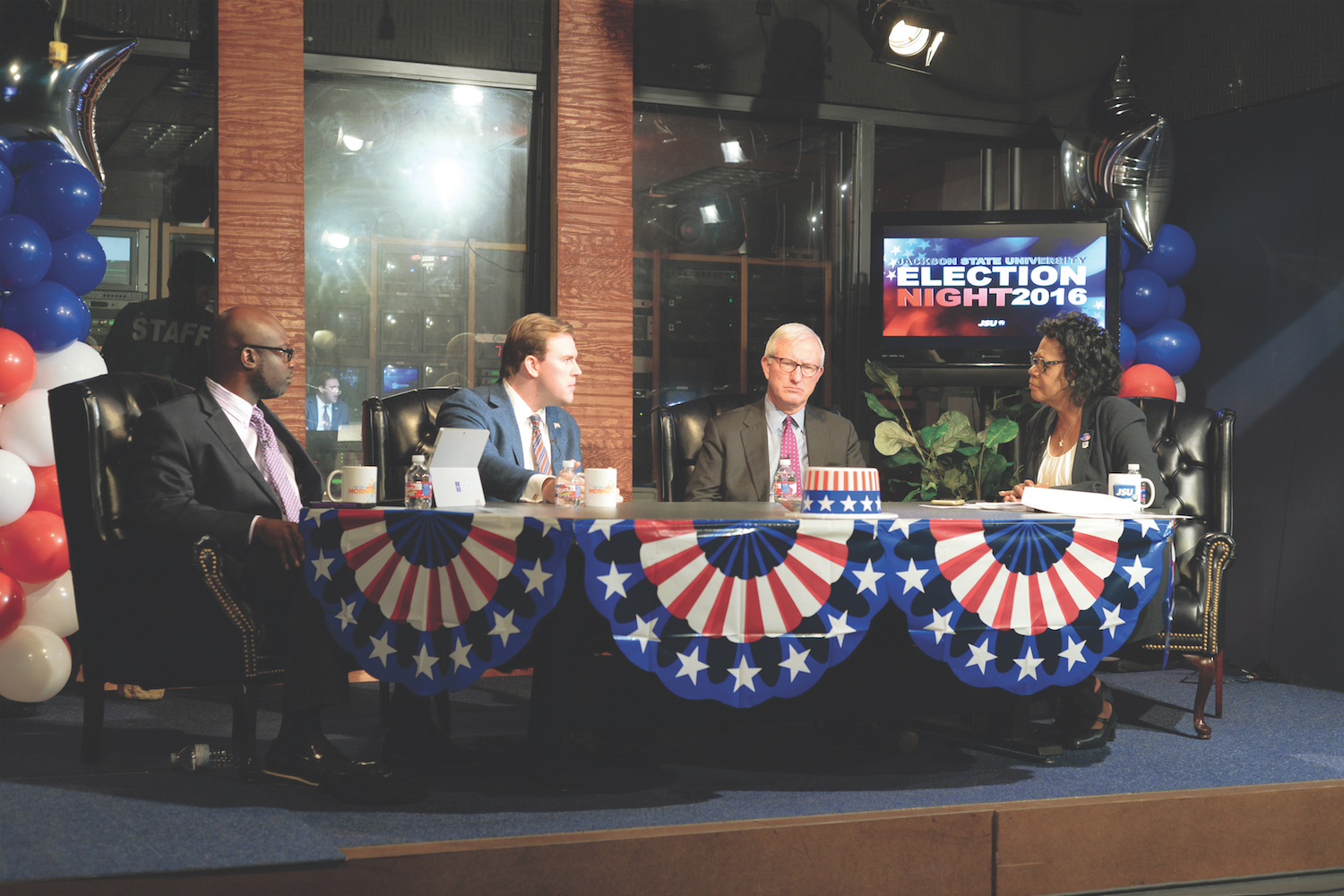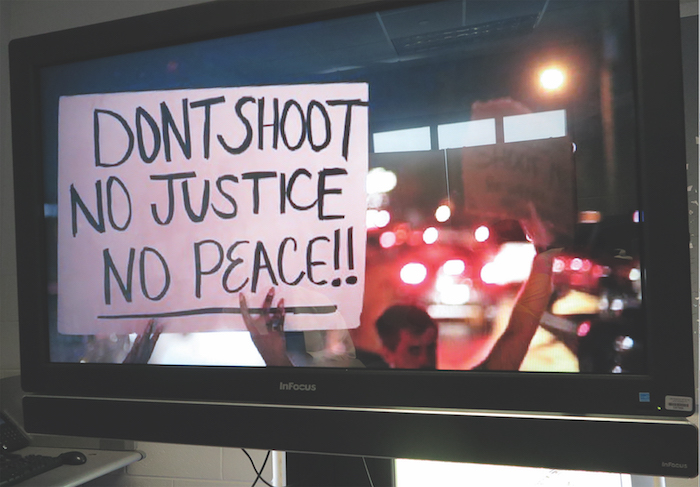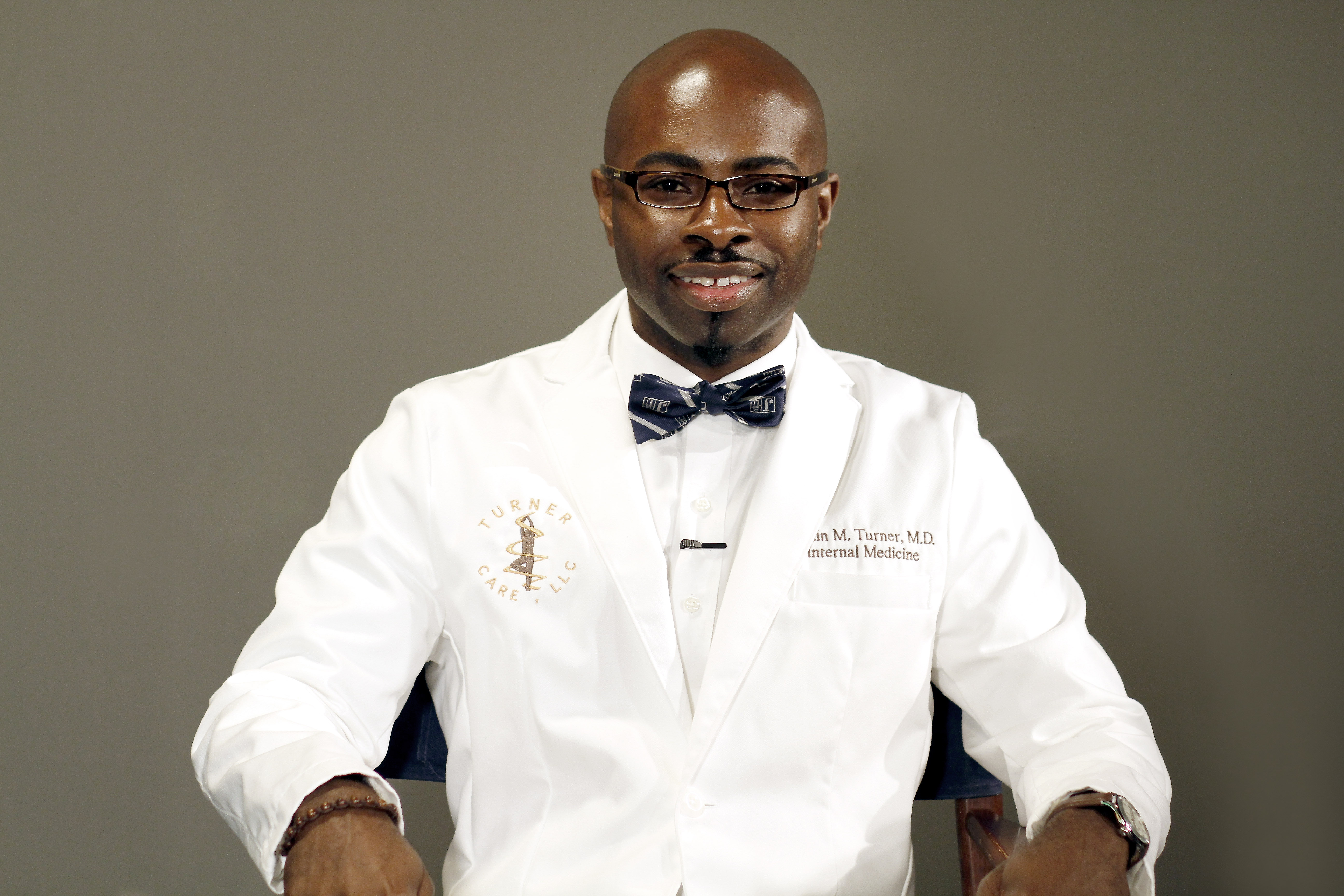[vc_row type=”” top_margin=”none”][vc_column type=”” top_margin=”none” width=”1/1″][vc_custom_heading text=”Pierce developed an innovative straw that successfully filters lead” font_container=”tag:h2|text_align:left” google_fonts=”font_family:Oswald%3A300%2Cregular%2C700″][/vc_column][/vc_row][vc_row type=”” top_margin=”none”][vc_column type=”” top_margin=”none” width=”1/2″][vc_column_text]

[/vc_column_text][/vc_column][vc_column type=”” top_margin=”none” width=”1/2″][vc_empty_space height=”32px”][vc_column_text]
Jackson State University student LaMonté Pierce, 36, has developed an innovative straw that successfully filters lead and other contaminants, and now one of the world’s largest retailers wants his newly patented device on its store shelves.
Pierce was spurred on by the city’s notorious boil-water notices. Pierce is pursuing his master’s degree in technology education at JSU; he earned his bachelor’s in industrial technology in 2017 from JSU’s College of Science, Engineering and Technology.
Pierce earned a patent for his “Cleanstraww,” a thin recyclable device that’s strikingly similar to a regular drinking straw. The material used in development of the product is FDA compliant and has been tested according to guidelines by the U.S. Environmental Protection Agency.
[/vc_column_text][/vc_column][/vc_row][vc_row type=”” top_margin=”none”][vc_column type=”” top_margin=”none” width=”1/1″][vc_empty_space height=”32px”][/vc_column][/vc_row][vc_row type=”” top_margin=”none”][vc_column type=”” top_margin=”none” width=”1/1″][vc_column_text]Pierce said the difference between his straw and other products on the market that remove contaminants is that Cleanstraww eliminates lead, too. It also costs a lot less money.
Ultimately, his device captured the attention of Walmart, which has offered Pierce a vendor contract.[/vc_column_text][/vc_column][/vc_row][vc_row type=”” top_margin=”none”][vc_column type=”” top_margin=”none” width=”1/1″][vc_empty_space height=”32px”][/vc_column][/vc_row][vc_row type=”” top_margin=”none”][vc_column type=”” top_margin=”none” width=”1/1″][vc_separator_pr style=”default” top_margin=”none”][/vc_column][/vc_row][vc_row type=”” top_margin=”none”][vc_column type=”” top_margin=”none” width=”1/1″][vc_empty_space height=”32px”][/vc_column][/vc_row][vc_row type=”” top_margin=”none”][vc_column type=”” top_margin=”none” width=”1/1″][vc_custom_heading text=”Elected to the 2019 Class of Fellows for the National Academy of Inventors” font_container=”tag:h2|text_align:left” google_fonts=”font_family:Oswald%3A300%2Cregular%2C700″][/vc_column][/vc_row][vc_row type=”” top_margin=”none”][vc_column type=”” top_margin=”none” width=”1/1″][vc_empty_space height=”32px”][/vc_column][/vc_row][vc_row type=”” top_margin=”none”][vc_column type=”” top_margin=”none” width=”1/2″][vc_column_text]

[/vc_column_text][/vc_column][vc_column type=”” top_margin=”none” width=”1/2″][vc_column_text]
Dr. Danuta Leszczynska was recently selected to the worldwide National Academy of Inventors Fellows Program. She earned a 2018 medical patent to eliminate inflammation and infection in patients whose artificial implants become brittle and start chipping.
Polish native Leszczynska is a longtime faculty member in the College of Science, Engineering and Technology. Currently, she’s a researcher and professor in the Department of Civil and Environmental Engineering and Industrial Systems and Technology.
Late last year, she was among 168 new fellows from throughout the globe elected fellows from throughout the globe elected to the 2019 Class of Fellows. Four are Nobel laureates. As well, she’s now one of 1,228 NAI fellows who represent more than 250 prestigious universities and governmental and nonprofit research institutes. According to NAI, these fellows hold more than 41,500 U.S.-issued patents that have created more than 36 million jobs and $1.6 trillion in revenue.
[/vc_column_text][/vc_column][/vc_row][vc_row type=”” top_margin=”none”][vc_column type=”” top_margin=”none” width=”1/1″][vc_empty_space height=”32px”][/vc_column][/vc_row][vc_row type=”” top_margin=”none”][vc_column type=”” top_margin=”none” width=”1/1″][vc_empty_space height=”32px”][/vc_column][/vc_row][vc_row type=”” top_margin=”none”][vc_column type=”” top_margin=”none” width=”1/1″][vc_separator_pr style=”default” top_margin=”none”][/vc_column][/vc_row][vc_row type=”” top_margin=”none”][vc_column type=”” top_margin=”none” width=”1/1″][vc_empty_space height=”32px”][/vc_column][/vc_row][vc_row type=”” top_margin=”none”][vc_column type=”” top_margin=”none” width=”1/1″][vc_custom_heading text=”Kafoury advocates sustainable communities to protect food, energy and water resources” font_container=”tag:h2|text_align:left” google_fonts=”font_family:Oswald%3A300%2Cregular%2C700″][/vc_column][/vc_row][vc_row type=”” top_margin=”none”][vc_column type=”” top_margin=”none” width=”1/1″][vc_empty_space height=”32px”][/vc_column][/vc_row][vc_row type=”” top_margin=”none”][vc_column type=”” top_margin=”none” width=”1/2″][vc_single_image image=”3994″ border_color=”grey” img_link_large=”” img_link_target=”_self” img_size=”large”][/vc_column][vc_column type=”” top_margin=”none” width=”1/2″][vc_column_text]
JSU’s College of Science, Engineering and Technology (CSET) has developed a cost-saving Sustainable Irrigation System (SIS) that could be used to determine just the right amount of water needed to saturate soil for gardening and agriculture.
The smart device, which includes sensors and an app, automatically activates a sprinkler system if stored rainwater is insufficient.
CSET developed the system after a challenge to build sustainable applications in local areas.
Dr. Ramzi Kafoury, associate professor in the Department of Biology and director of Sustainability and Technology Systems in CSET, created and directed the project. He’s working collaboratively with several CSET students who were responsible for developing an app and Dr. Francis Tuluri, a JSU professor in civil and environmental engineering. Ramzi and Tuluri handled the circuitry and sensors.
[/vc_column_text][/vc_column][/vc_row][vc_row type=”” top_margin=”none”][vc_column type=”” top_margin=”none” width=”1/1″][vc_empty_space height=”32px”][/vc_column][/vc_row][vc_row type=”” top_margin=”none”][vc_column type=”” top_margin=”none” width=”1/1″][vc_empty_space height=”32px”][/vc_column][/vc_row][vc_row type=”” top_margin=”none”][vc_column type=”” top_margin=”none” width=”1/1″][vc_separator_pr style=”default” top_margin=”none”][/vc_column][/vc_row][vc_row type=”” top_margin=”none”][vc_column type=”” top_margin=”none” width=”1/1″][vc_empty_space height=”32px”][/vc_column][/vc_row][vc_row type=”” top_margin=”none”][vc_column type=”” top_margin=”none” width=”1/1″][vc_custom_heading text=”DURP have produced findings related to environmental change” font_container=”tag:h2|text_align:left” google_fonts=”font_family:Oswald%3A300%2Cregular%2C700″][/vc_column][/vc_row][vc_row type=”” top_margin=”none”][vc_column type=”” top_margin=”none” width=”1/1″][vc_empty_space height=”32px”][/vc_column][/vc_row][vc_row type=”” top_margin=”none”][vc_column type=”” top_margin=”none” width=”1/2″][vc_column_text]

[/vc_column_text][/vc_column][vc_column type=”” top_margin=”none” width=”1/2″][vc_column_text]
The Department of Urban and Regional Planning in the College of Science Engineering and Technology and its research partners have produced findings related to environmental change, renewable energy (geothermal), water resources, land resource management and food security in the U.S. and sub-Saharan Africa.
Experts say core research shows that the western region of the U.S. faces increased water depletion as major aquifers decline at a much faster rate than expected due to socio-economic, environmental and physical factors.
They says habitats in Mississippi still face widespread devastation. In fact, massive acres of wetlands, streams and coastal resources such as pine savannahs in the Delta and the Gulfport region have been degraded because of sedimentation and human activities.
Elsewhere, in West Africa, for example, the tragedy of illegal fishing by foreign trawlers along the coastal areas of the region is prompting the extinction of local fish species at a scale that threatens community livelihoods from Senegal to Nigeria.
[/vc_column_text][/vc_column][/vc_row][vc_row type=”” top_margin=”none”][vc_column type=”” top_margin=”none” width=”1/1″][vc_empty_space height=”32px”][/vc_column][/vc_row][vc_row type=”” top_margin=”none”][vc_column type=”” top_margin=”none” width=”1/1″][vc_column_text]The collaborative work involved JSU researchers and students led by Dr. Edmund Merem, Dr. Yaw Twumasi and Dr. Joan Wesley. Academic areas included JSU’s College of Public Health; and JSU’s Department of Public Policy and Administration in the College of Liberal Arts. Expertise also was provided by the Department of Urban Forestry and Natural Resources at Southern University A&M in Baton Rouge, Louisiana.[/vc_column_text][/vc_column][/vc_row][vc_row type=”” top_margin=”none”][vc_column type=”” top_margin=”none” width=”1/1″][vc_empty_space height=”32px”][/vc_column][/vc_row][vc_row type=”” top_margin=”none”][vc_column type=”” top_margin=”none” width=”1/1″][vc_empty_space height=”32px”][/vc_column][/vc_row][vc_row type=”” top_margin=”none”][vc_column type=”” top_margin=”none” width=”1/1″][vc_separator_pr style=”default” top_margin=”none”][/vc_column][/vc_row][vc_row type=”” top_margin=”none”][vc_column type=”” top_margin=”none” width=”1/1″][vc_empty_space height=”32px”][/vc_column][/vc_row][vc_row type=”” top_margin=”none”][vc_column type=”” top_margin=”none” width=”1/1″][vc_custom_heading text=”Berhie aims to infuse 21st-century technology into academic programs at JSU” font_container=”tag:h2|text_align:left” google_fonts=”font_family:Oswald%3A300%2Cregular%2C700″][/vc_column][/vc_row][vc_row type=”” top_margin=”none”][vc_column type=”” top_margin=”none” width=”1/2″][vc_empty_space height=”32px”][vc_column_text]

[/vc_column_text][/vc_column][vc_column type=”” top_margin=”none” width=”1/2″][vc_column_text]Dr. Girmay Berhie is the new dean of the state’s only accredited School of Public Health, and he aims to infuse 21st-century technology into academic programs at Jackson State University so that health professionals can better serve the world.
Berhie, a native of Ethiopia, was educated in St. Louis, Missouri. He earned his doctorate in public policy analysis and evaluation from Saint Louis University, where he also received his master’s in social work. As well, he’s completed a master’s in information systems from Marshall University and studied biostatistics and epidemiology at John Hopkins University.
He said Mississippi’s greatest challenges are economic and social issues as well as health care. “The School of Public Health will create partnerships with community stakeholders in finding common grounds for research, dialogue and reflection on important public and health policy matters. The school will assist in attracting federal, state, local and private funds that will aid public and health policies, teaching and community awareness,” he said.[/vc_column_text][/vc_column][/vc_row][vc_row type=”” top_margin=”none”][vc_column type=”” top_margin=”none” width=”1/1″][vc_empty_space height=”32px”][/vc_column][/vc_row][vc_row type=”” top_margin=”none”][vc_column type=”” top_margin=”none” width=”1/1″][vc_column_text]His goals are to develop a school of informatics and analytics; several programs are ready for submission along with an epidemiology/biostatistics online certificate program.[/vc_column_text][/vc_column][/vc_row][vc_row type=”” top_margin=”none”][vc_column type=”” top_margin=”none” width=”1/1″][vc_empty_space height=”32px”][/vc_column][/vc_row][vc_row type=”” top_margin=”none”][vc_column type=”” top_margin=”none” width=”1/1″][vc_separator_pr style=”default” top_margin=”none”][/vc_column][/vc_row][vc_row type=”” top_margin=”none”][vc_column type=”” top_margin=”none” width=”1/1″][vc_empty_space height=”32px”][/vc_column][/vc_row][vc_row type=”” top_margin=”none”][vc_column type=”” top_margin=”none” width=”1/1″][vc_custom_heading text=”Herbert focuses on socio-economic development and more” font_container=”tag:h2|text_align:left” google_fonts=”font_family:Oswald%3A300%2Cregular%2C700″][/vc_column][/vc_row][vc_row type=”” top_margin=”none”][vc_column type=”” top_margin=”none” width=”1/1″][vc_empty_space height=”32px”][/vc_column][/vc_row][vc_row type=”” top_margin=”none”][vc_column type=”” top_margin=”none” width=”1/2″][vc_single_image image=”4333″ border_color=”grey” img_link_large=”” img_link_target=”_self” img_size=”full”][/vc_column][vc_column type=”” top_margin=”none” width=”1/2″][vc_column_text]Dr. Berneece Herbert is the new chair for the Department of Urban and Regional Planning (DURP). Herbert is an experienced educator with more than 20 years of expertise in planning, academia, research and outreach. Before her appointment at JSU, she worked as a faculty member in the Department of Community and Regional Planning at Alabama A&M University. During her 13-year tenure, she also spent three of those years as the department’s interim chair.
“Jackson State is the sister school to Alabama A&M in terms of programs, so I knew I had to pursue this position,” Herbert said. “While searching for a new opportunity, I always kept in mind that I wanted to continue working in the HBCU environment.”
As an urban planner, Herbert focuses on socio-economic development, strategic planning and management, public-sector investment planning and policy formulation. Her research areas are urban health indicators, sustainable economic development and social equity focusing on food access and security, poverty and hunger, greenhouse gas emissions and public perception.[/vc_column_text][/vc_column][/vc_row][vc_row type=”” top_margin=”none”][vc_column type=”” top_margin=”none” width=”1/1″][vc_empty_space height=”32px”][/vc_column][/vc_row][vc_row type=”” top_margin=”none”][vc_column type=”” top_margin=”none” width=”1/1″][vc_empty_space height=”32px”][/vc_column][/vc_row][vc_row type=”” top_margin=”none”][vc_column type=”” top_margin=”none” width=”1/1″][vc_separator_pr style=”default” top_margin=”none”][/vc_column][/vc_row][vc_row type=”” top_margin=”none”][vc_column type=”” top_margin=”none” width=”1/1″][vc_empty_space height=”32px”][/vc_column][/vc_row][vc_row type=”” top_margin=”none”][vc_column type=”” top_margin=”none” width=”1/1″][vc_custom_heading text=”Walters focused on helping students achieve career success” font_container=”tag:h2|text_align:left” google_fonts=”font_family:Oswald%3A300%2Cregular%2C700″][/vc_column][/vc_row][vc_row type=”” top_margin=”none”][vc_column type=”” top_margin=”none” width=”1/1″][vc_empty_space height=”32px”][/vc_column][/vc_row][vc_row type=”” top_margin=”none”][vc_column type=”” top_margin=”none” width=”1/2″][vc_single_image image=”3998″ border_color=”grey” img_link_large=”” img_link_target=”_self” img_size=”large”][/vc_column][vc_column type=”” top_margin=”none” width=”1/2″][vc_column_text]Dr. Wilbur Walters is the new dean of the College of Science, Engineering and Technology (CSET), and he has big plans for CSET’s current and future students.
His ideas include student town-hall meetings so they can share their opinions with faculty and staff for improving their academic experiences. Another big push will be to offer courses online for new and existing programs.
Walters said he’s laser-focused on helping students achieve career success.
“There are no limits as to what we can do in terms of impacting our students,” Walters said. “We want to build a very robust, comprehensive experience for all our students in the college.”
Walters said CSET will support JSU’s mission by continuing to engage in partnerships with several companies and universities. He said he expects the effort to foster more faculty-student research and student academic interaction.
“Ultimately, we want to train students for the next 10 years, especially with new tools and software changes. We want to develop young people who can think and use all the tools and strengths available to solve problems,” Walters said.[/vc_column_text][/vc_column][/vc_row]









Got a Questions?
Find us on Socials or Contact us and we’ll get back to you as soon as possible.